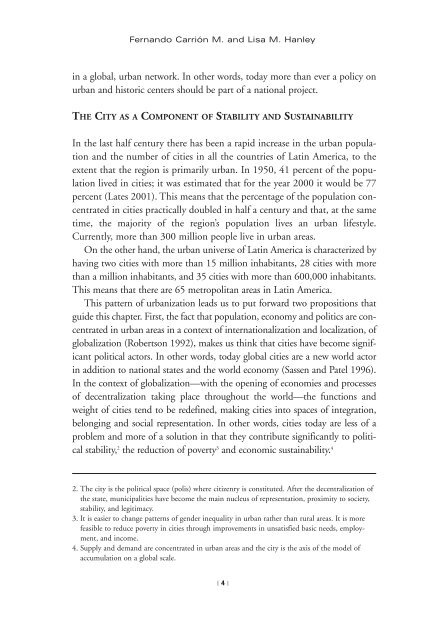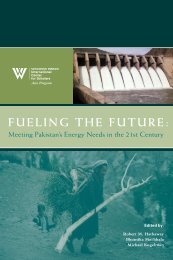urban regeneration and revitalization in the americas - Woodrow ...
urban regeneration and revitalization in the americas - Woodrow ...
urban regeneration and revitalization in the americas - Woodrow ...
You also want an ePaper? Increase the reach of your titles
YUMPU automatically turns print PDFs into web optimized ePapers that Google loves.
Fern<strong>and</strong>o Carrión M. <strong>and</strong> Lisa M. Hanley<br />
<strong>in</strong> a global, <strong>urban</strong> network. In o<strong>the</strong>r words, today more than ever a policy on<br />
<strong>urban</strong> <strong>and</strong> historic centers should be part of a national project.<br />
THE CITY AS A COMPONENT OF STABILITY AND SUSTAINABILITY<br />
In <strong>the</strong> last half century <strong>the</strong>re has been a rapid <strong>in</strong>crease <strong>in</strong> <strong>the</strong> <strong>urban</strong> population<br />
<strong>and</strong> <strong>the</strong> number of cities <strong>in</strong> all <strong>the</strong> countries of Lat<strong>in</strong> America, to <strong>the</strong><br />
extent that <strong>the</strong> region is primarily <strong>urban</strong>. In 1950, 41 percent of <strong>the</strong> population<br />
lived <strong>in</strong> cities; it was estimated that for <strong>the</strong> year 2000 it would be 77<br />
percent (Lates 2001). This means that <strong>the</strong> percentage of <strong>the</strong> population concentrated<br />
<strong>in</strong> cities practically doubled <strong>in</strong> half a century <strong>and</strong> that, at <strong>the</strong> same<br />
time, <strong>the</strong> majority of <strong>the</strong> region’s population lives an <strong>urban</strong> lifestyle.<br />
Currently, more than 300 million people live <strong>in</strong> <strong>urban</strong> areas.<br />
On <strong>the</strong> o<strong>the</strong>r h<strong>and</strong>, <strong>the</strong> <strong>urban</strong> universe of Lat<strong>in</strong> America is characterized by<br />
hav<strong>in</strong>g two cities with more than 15 million <strong>in</strong>habitants, 28 cities with more<br />
than a million <strong>in</strong>habitants, <strong>and</strong> 35 cities with more than 600,000 <strong>in</strong>habitants.<br />
This means that <strong>the</strong>re are 65 metropolitan areas <strong>in</strong> Lat<strong>in</strong> America.<br />
This pattern of <strong>urban</strong>ization leads us to put forward two propositions that<br />
guide this chapter. First, <strong>the</strong> fact that population, economy <strong>and</strong> politics are concentrated<br />
<strong>in</strong> <strong>urban</strong> areas <strong>in</strong> a context of <strong>in</strong>ternationalization <strong>and</strong> localization, of<br />
globalization (Robertson 1992), makes us th<strong>in</strong>k that cities have become significant<br />
political actors. In o<strong>the</strong>r words, today global cities are a new world actor<br />
<strong>in</strong> addition to national states <strong>and</strong> <strong>the</strong> world economy (Sassen <strong>and</strong> Patel 1996).<br />
In <strong>the</strong> context of globalization—with <strong>the</strong> open<strong>in</strong>g of economies <strong>and</strong> processes<br />
of decentralization tak<strong>in</strong>g place throughout <strong>the</strong> world—<strong>the</strong> functions <strong>and</strong><br />
weight of cities tend to be redef<strong>in</strong>ed, mak<strong>in</strong>g cities <strong>in</strong>to spaces of <strong>in</strong>tegration,<br />
belong<strong>in</strong>g <strong>and</strong> social representation. In o<strong>the</strong>r words, cities today are less of a<br />
problem <strong>and</strong> more of a solution <strong>in</strong> that <strong>the</strong>y contribute significantly to political<br />
stability, 2 <strong>the</strong> reduction of poverty 3 <strong>and</strong> economic susta<strong>in</strong>ability. 4<br />
2. The city is <strong>the</strong> political space (polis) where citizenry is constituted. After <strong>the</strong> decentralization of<br />
<strong>the</strong> state, municipalities have become <strong>the</strong> ma<strong>in</strong> nucleus of representation, proximity to society,<br />
stability, <strong>and</strong> legitimacy.<br />
3. It is easier to change patterns of gender <strong>in</strong>equality <strong>in</strong> <strong>urban</strong> ra<strong>the</strong>r than rural areas. It is more<br />
feasible to reduce poverty <strong>in</strong> cities through improvements <strong>in</strong> unsatisfied basic needs, employment,<br />
<strong>and</strong> <strong>in</strong>come.<br />
4. Supply <strong>and</strong> dem<strong>and</strong> are concentrated <strong>in</strong> <strong>urban</strong> areas <strong>and</strong> <strong>the</strong> city is <strong>the</strong> axis of <strong>the</strong> model of<br />
accumulation on a global scale.<br />
| 4 |

















